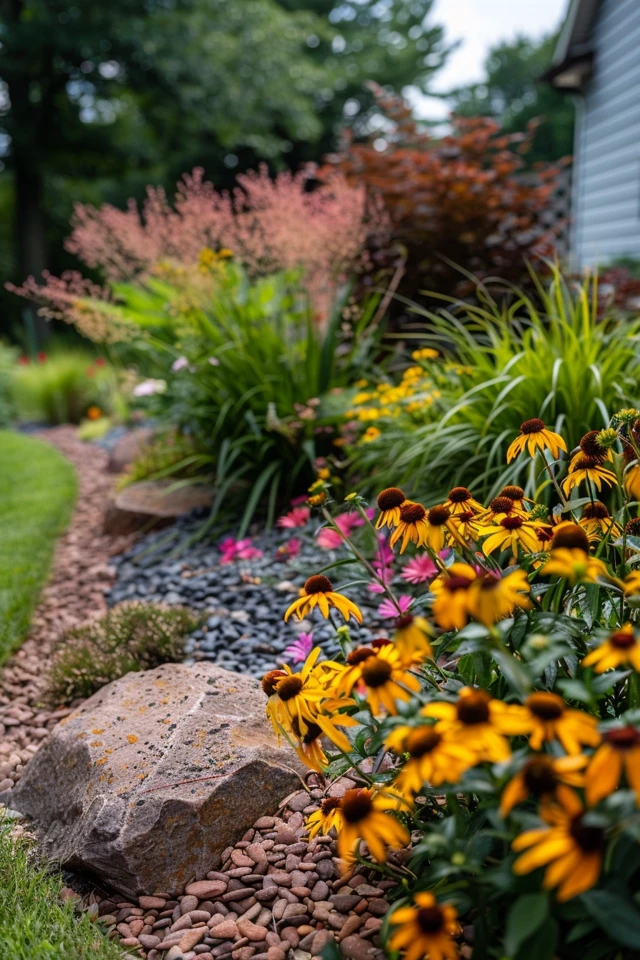When it comes to landscaping around a septic mound, there are important factors to consider for both functionality and aesthetic appeal. Proper septic tank and mound design, as well as thoughtful septic system landscaping, can ensure the longevity and efficiency of your system, while also creating an attractive outdoor environment. In this article, I will share some valuable tips and ideas to help you achieve a well-maintained and visually appealing septic mound landscape.
Key Takeaways:
- Plant grass or maintain existing native vegetation around the septic mound.
- Direct surface drainage away from the septic system.
- Use shallow-rooted plants to prevent root intrusion in the drainlines.
- Avoid planting edible plants and vegetable gardens near the drainfield.
- Select native, drought-tolerant plants and grasses for septic mound landscaping.

Native Plants and Grasses for Septic Mound Landscaping
When it comes to septic mound landscaping, selecting the right plants is crucial for both functionality and aesthetics. Native plants and drought-tolerant grasses are ideal choices for these areas, as they are well-adapted to the dry conditions typically found in septic mound landscapes.
One excellent option for septic mound grasses is fescue, a resilient and low-maintenance grass that thrives in various soil types. Another popular choice is lawn grass, which provides a lush, green carpet-like appearance. Ornamental grasses, such as maiden grass or fountain grass, can add texture and visual interest to your septic mound landscape.
Groundcovers are also an essential component of septic mound landscaping. Bugleweed, with its vibrant flowers and dense foliage, is a great groundcover option that can help prevent erosion. Cotoneaster, known for its drought tolerance and colorful berries, provides year-round visual appeal. Periwinkle, with its glossy leaves and delicate blue flowers, is another groundcover that thrives in septic mound areas.
Choosing the right plants for your septic mound landscape is crucial. Native plants and grasses not only enhance the visual appeal but also help maintain the proper functioning of the septic system.
For shaded areas around the septic mound, ferns, mosses, and wild ginger can create a lush and vibrant atmosphere. These plants thrive in low-light conditions and add a touch of natural beauty to your landscape.
It’s important to remember that the placement of trees near septic mounds requires careful consideration. To avoid the risk of damage to the drainfield, trees and shrubs should be planted at least 20 feet away from the mound. This precaution prevents root intrusion and ensures the longevity of your septic system.
By selecting native plants, drought-tolerant grasses, and appropriate groundcovers, you can create a vibrant and visually appealing septic mound landscape that complements your home’s aesthetics while maintaining the functionality of your septic system.

Best Practices for Landscaping Around a Septic System
When it comes to landscaping around a septic system, following best practices is essential for maintaining the system’s functionality and ensuring a visually appealing environment. One important aspect to consider is preventing erosion by planting vegetation close together. The root systems of plants help clump the soil together, reducing erosion and creating a stable ground surface for the septic mound.
Another crucial tip is to avoid planting edible plants near the septic tank. These plants have the potential to absorb harmful bacteria from the septic system, posing a risk to your health and the environment. It’s best to choose non-edible plants that are well-suited for septic mound landscaping, such as native grasses, groundcovers, and ornamental plants.
Proper drainage is also crucial for maintaining the health of the septic system. It is important to direct surface water away from the septic field to prevent oversaturation. Implementing appropriate drainage solutions, such as swales or French drains, can help channel water away from the system and avoid potential damage or failure.
When incorporating trees into your septic system landscape, keep in mind that their roots can intrude and damage the drainfield. To prevent this, it is recommended to plant trees at least 20 feet away from the septic system. This distance helps ensure that the tree roots won’t reach the drainlines, safeguarding the system’s integrity for years to come. Lastly, marking the access hatch for the septic tank is crucial for easy maintenance and inspections, allowing professionals to access the system quickly.


